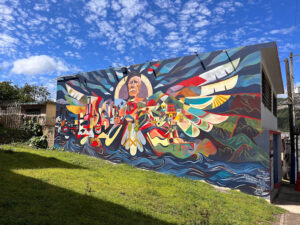
Alas, our last full day in Puerto Rico arrived, and it seemed a moment too soon. We wanted one last day in San Juan proper, but we took a little detour on our way there from Jayuya to visit El Museo del Café de Puerto Rico, a little museum located in a little town called Ciales.
Ciales is a charmingly quaint town of less than 20,000 people, and a colorful mural honoring poet, journalist, and pro-independence activist Juan Antonio Corretjer welcomed us after we parked our car. The mural was painted by artist Cristian Roldán who grew up in Puerto Rico but has since moved to Chicago. The artwork not only celebrates Corretjer but also highlights the culture of Puerto Rico with images of its mountains and its towns while also acknowledging the despair that many Puerto Ricans feel, choosing to leave the island behind often for good, which is depicted by images of U.S. cityscapes, including an image of the Willis Tower in Chicago. The mural again served as a reminder to me that I don’t believe there are any easy answers for how to solve Puerto Rico’s question of becoming independent, becoming a state, or remaining a commonwealth. There is much passion and emotion surrounding this problem, and it will be difficult to find any sort of solution that satisfies some without leaving others behind.
We continued to walk down the main drag of Ciales to eventually enjoy our visit to the coffee museum. Like Ciales, the museum is also small but quite a delight and it doesn’t take long to view the entire place, appreciating old artifacts like antique coffee mills and giant mortars and pestles as well as old documents and ledgers.
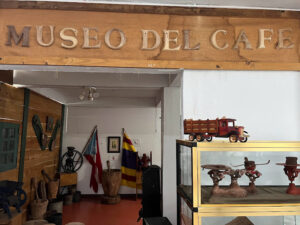
Next door to the museum is the Don Pello Coffee Shop, where we discovered we were quite famished. The menu featured plates that wouldn’t look out of place at any diner in the states (waffles, omelets, pancakes, fried eggs with ham, and so on), except the view as we sat outside under a pavilion was characteristically and uniquely Puerto Rican—those lush, green, rolling mountains; those vibrant flamboyan trees with their blazing orange flowers just beginning to appear in time for spring; all accompanied by that impossibly comfortable Puerto Rican air that persistently invited us to enjoy its warming presence. The cafe also had a petting zoo where we could express our love to small bunnies, baby goats, and a particularly vocal donkey.
Soon we were on the road again towards San Juan, making our way to a district in the city called Santurce, known for its street art. When we arrived, we parked in a ramp near the Museum of Contemporary Art of Puerto Rico and then walked down a main drag, Avenida Juan Ponce de León, on a mission to find unos artes de las calles. In the process of looking, we walked past the Miramar Food Truck Park, which we had visited earlier in the week (and I still advise that you make a trip to enjoy some incredible food there) and then proceeded to walk south down Calle Cerra. It was on this street that we started to find some of the best graffiti art we had yet seen in the city.
But before we could enjoy all the art on this street, we naturally found ourselves a little thirsty and decided to visit a lovely place called El Axolote, a self-proclaimed restaurante mexicano. Our camarero was at once helpfully instructive, dashingly charming, and—how do I say this—overtly devious, which I’ll get to in a moment.
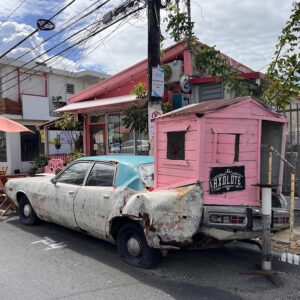
As it was a mexican restaurant, mezcal was on the menu, so we ordered paloma mezcals. Normally, of course, palomas are made with tequila, but the smoky overtones of the mezcal added an earthy shade of flavor to the citrusy, summertime drink. When our waiter returned to ask how the drinks were, I remarked, “¡Muy delicioso!” and he laughed a bit and said, “No, don’t say that about a drink. Say, ‘Está bueno’. Or you could say, ‘Está cabrón’.”
We, of course, were too quick for him as we had already learned that cabrón is a word not to use with your boss (recall that it translates to many things, including bastard and bitch), as we had learned on día tres from a group of ladies we met while Aaron and I were ziplining. That said, it was helpful to learn that the ladies at Toro Verde were not pulling our legs, as our waiter’s naughty Spanish lesson helped validate theirs.
I then asked him if you ever would say, “Muy delicioso,” about something you’re eating or drinking, and he said that he might say that while he would be, er, enjoying a rather adult sampling of a specific, private body part of a certain gender, if you understand my meaning. The shameless gall of our camarero joven started to reveal itself, but these more adult-themed conversaciones are what help you to really get to know una lengua.
After enjoying a second round of drinks, we felt it was time to carry on with our street art tour. Before we left our table, I had asked our waiter, “¿Dónde está el mejor arte en la calle?” and he recommended we go to the nearby Museum of Contemporary Art of Puerto Rico where we had parked our car, commenting that he doesn’t really have suggestions for arte bueno en la calle, as he sees it all the time and doesn’t really pay attention to it.
As we were exiting, our waiter made one last overture, indicating that he was getting off work in a half hour and that we should join him for more drinks at a bar called El Nie, buttering us up even more by complimenting our clothes, particularly my very own geeky look. We asked what El Nie meant, and he struggled to translate the word for us, and instead asked (brace yourself for some more uncensored language), “What’s the name for that body part in a man’s butt?”
“A taint?” I asked.
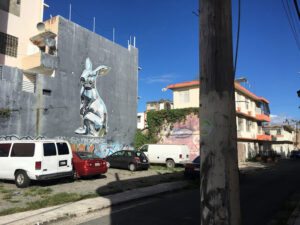
He agreed that was the word he was looking for and then explained that el nie means the taint, and the bar was named so because it’s located in the middle of a short block and isn’t really next to either street that surrounds it. Whether or not this translation of the word is true, I cannot substantiate, as none of the dictionaries I’ve been using seem to have an entry for the word.
Before we finally did leave El Axolote, our waiter additionally explained that he’s banned from El Nie but that if he brought the three of us that they would let him in. (We decided not to take him up on that.) As the afternoon was fading fast, we bid farewell to our mischievous friend so we could continue our tour of art while the light was still out.
There were many glorious murals to see on this street as we walked farther south down Calle Cerra, and many of these murals dominated entire building facades standing three or four stories high: a bold, close-up image of a blonde-haired woman wearing sunglasses reflecting an olive; a giant jackrabbit standing on its hind legs and painted in strikingly cool colors of blues and greys; a haunting image of a woman floating in a forest wearing a box on her head, an image of a skull appearing on the box exactly where her head would be; a young girl sitting on a tree branch cradling a little seedling in the palms of her hands. There was so much to see, and it was gratifying to see artists investing their time and energy in beautifying this part of town with their love of bold colors and striking images.
We eventually made our way to the intersection of Calle Cerra and Avenida las Palmas where we decided to head east and then north back towards the car, as we wanted to enjoy one, last excursion into Viejo San Juan, accidentally walking past El Nie in the process, making sure our naughty waiter didn’t hijack the rest of our day. This part of town, sadly, was clearly still recovering from Maria even though the disaster happened four-and-a-half years ago: sidewalks and curbs were dirty, oily, and crumbing; boulevards were dusty and sandy and devoid of vibrant grasses; shuttered storefronts were overrun with sad, feral cats, the scent of piss and shit permeating the air; a giant, concrete, inhabited apartment complex that looked like something out of 28 Days Later rather than something belonging in a commonwealth that apparently belongs to one of the richest countries in the world. I couldn’t help but feel that we were intrusively encroaching on neighborhoods with a fetishistic desire to view urban decay, so while I’m grateful to have seen this part of San Juan, it felt appropriate to move on.
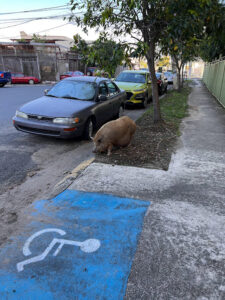
All of this said, it was inexplicable to us that this is just how it is in Puerto Rico, not only in San Juan, but all throughout the entire island, once warmly inviting homes now entirely dilapidated and abandoned. I honestly just don’t know how this is allowed to be or what the solution is, and I was reminded of what our bartender at Skryer said the previous day, “It’s not a matter of if we leave the island but when.”
We eventually arrived in Viejo San Juan, and we wanted to have drinks at El Convento Hotel, upon the recommendation of our food tour guide, Ricardo, but the hotel restaurant was closed for a private party, so we instead made our way to Marilyn’s Place, where we were delighted to once again encounter Ricardo who was in the middle of the Rum Runners cocktail tour with another group, and he recognized us and seemed delighted that we were enjoying cocktails at Marilyn’s Place. On their sidewalk tables underneath umbrellas, we enjoyed a Brazilian classic, caipirinha, except flavored with a Puerto Rican twist, parcha (passion fruit).
Learning from our difficulties yesterday trying to find a restaurant that had availability, we made reservations at Princesa Cocina Cultura, a restaurant located right on Paseo de la Princesa, a beautiful pedestrian street near the waterfront we had visited previously. We made our way there, taking a somewhat scenic route through La Puerta de San Juan and then along Paseo del Morro, to marvel at one, final, enchanting Puerto Rican sunset.
Princesa Cocina Cultura had ample outdoor seating, and we got to enjoy one last evening meal under a giant gazebo next to an ancient tree adorned with sparkling fairy lights that magically lit up the area as the evening turned to night. We enjoyed canastas de yuca y ropa vieja and molletes criollos to start. Canastas are essentially mashed plantains shaped into a cup, fried in oil, and then filled with whatever you want, in this case yuca and ropa vieja, which is a kind of beef stew. Molletes criollos are thickly sliced pieces of bread, toasted, and topped with pork and tomatoes with melted brie.
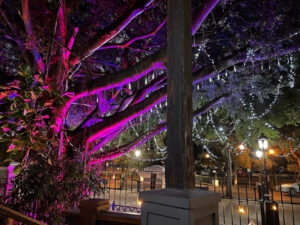
For our mains Aaron enjoyed a red snapper, Amy a mahi mahi, and I a lamb piñon. Aaron and I absolutely loved our dishes, but poor Amy was less than impressed with hers. I tried a bit, and the best I can describe it is that it tasted like hot fish water, bland and devoid of flavor. It was really too bad, as everything else was so, so good.
We also enjoyed a hefty sampling of cocktails and sparkling wine, and as the evening progressed, a somewhat substantial rainfall joined us, but the gazebo provided ample covering. It actually was quite enchanting, enjoying a meal that was (mostly) transcendent, fairy lights glimmering in an aged tree, rain falling all around us. One of San Juan’s resident cats also joined us under the gazebo, and he, too, looked as if he was enjoying his time at the restaurant, his healthy weight a sign that he knew where to find the best food.
Eventually the rain subsided and it was time to head back to Jayuya for one last jaunt into the mountains. It was challenging to not allow feelings of melancholy to overcome ourselves as we bid farewell to Viejo San Juan, walking past all of the city’s colorful building facades and iconic blue cobblestone streets. But it wasn’t quite goodbye to Puerto Rico just yet, as we had one final sight to check off our list on our very last day on this gorgeous, yet troubled, little island…
Spanish lesson for the day:
- We generally were pretty careful about what kind of water we were drinking in Puerto Rico—nothing from the taps, for example. And when we were in restaurants we frequently asked for bubbly water so we’d receive water out of a bottle. “Agua con gas,” is how you’d order that, and our camarero at El Axolote seemed impressed that we knew how to say that.
- If you want to know what sparkling wines are available at a restaurant and not just champagne, you can ask, “¿Qué vinos espumosos tiene?” or “What sparkling wines do you have?”
- Usar is a handy verb which means to use. At El Axolote, Amy asked, “Qué mezcal usas?” which is, “What mezcal do you use?” The waiter responded, “Uso…” which is, “I use…” and then proceeded to list off the mezcals they have.
Travel tips, day eleven:
- Today was the first day where we encountered a local who grew frustrated that we were unable to to speak Spanish very well. It happened while we were trying to buy coffee beans from the coffee museum. “Quiero comprar,” Aaron said while holding up a bag of coffee beans, to which the clerk spoke something rapidly in response. Amy added, “Lo siento, no entiendo.” Exasperated, the clerk got a coworker—who seemed embarrassed by what had just happened—who then explained that her colleague was trying to figure out what kind of roast we wanted. Again, this was the first time we had a difficult exchange like this, but the best you can do is just continue to speak calmly (speaking more loudly never solves anything) and try the best you can as you conjugate the wrong verb or use a mismatched article to its noun.
- As you can imagine, Puerto Rico has many palm trees, but my favorite has to be a fluffier variety called the royal palm. They look as if they’ve come out of a Dr. Seuss book, especially when the wind buffets their feathery leaves about.
- It’s clear that they dump more money into Viejo San Juan as that’s where the cruise ships dock and where most of the tourists spend their time. But I highly recommend you try to visit areas of San Juan that are outside of Viejo San Juan, as the other parts of town allow you to really see the real San Juan, so step outside the box if you can.
*These photos by Amy Danielson. All others by me.
